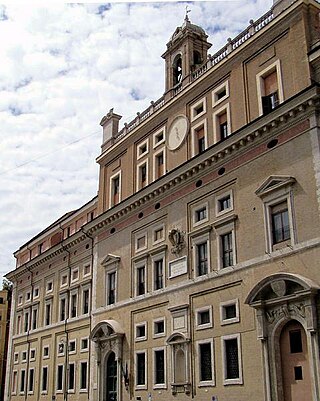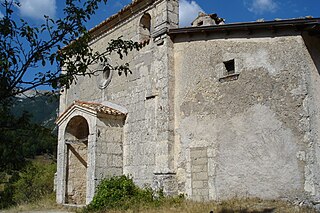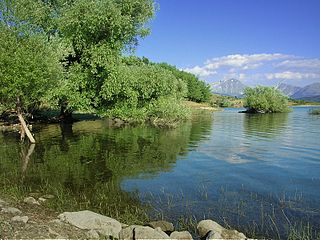| Place of origin | Italy |
|---|---|
| Region or state | Abruzzo |
| Main ingredients | Escabeche, saffron [1] |
Scapece alla vastese is a traditional dish from the Abruzzo region of Italy. In its preparation mackerel and oily fish are used; then, once fried, the fish is immersed in vinegar and saffron which gives it the intense yellow color that characterizes it. [2] [3] [4]

Abruzzo, historically known as Abruzzi, is a region of Southern Italy with an area of 10,763 square km and a population of 1.3 million. It is divided into four provinces: L'Aquila, Teramo, Pescara, and Chieti. Its western border lies 80 km (50 mi) east of Rome. Abruzzo borders the region of Marche to the north, Lazio to the west and north-west, Molise to the south and the Adriatic Sea to the east. Geographically, Abruzzo is divided into a mountainous area in the west, which includes the highest massifs of the Apennines, such as the Gran Sasso d'Italia and the Maiella, and a coastal area in the east with beaches on the Adriatic Sea.

Pietro Cascella was an Italian sculptor. His principal work consisted of large monumental sculptures, including the International Monument to the Victims of Fascism in the Auschwitz II-Birkenau death camp in Poland (1957–1967), and an underground mausoleum for Silvio Berlusconi at his villa in Arcore in the 1980s.

Penne is an Italian town in the province of Pescara, in the Abruzzo region, in mid-southern Italy. According to the last census in 2014 the population was 12,451. It is one of I Borghi più belli d'Italia.

The Ministry of Culture is the ministry of the Government of Italy in charge of national museums and the monuments historiques. MiC's headquarters are located in the historic Collegio Romano Palace and the current Minister of Culture is Gennaro Sangiuliano.

Ventricina is a traditional dry fermented pork sausage commonly produced in the Abruzzo region of Italy. Its most common artisanal version, ventricina del vastese, from the Vasto area, is made with large pieces of fat and lean pork.

A bocconotto is a pastry typical of the Italian regions of Apulia, Abruzzo and Calabria. It is often eaten at Christmas.

Tourism in Abruzzo has become one of the most prosperous sectors in the economy of Abruzzo, and in recent years has seen a remarkable growth attracting numerous tourists from Italy and Europe. According to statistics, in 2021 arrivals totaled 1,330,887. A total of 5,197,765 arrivals were tourists, a figure that puts the region seventeenth among the Italian regions for numbers of tourists per year. A moderate support to tourism is also given to the Abruzzo Airport with many low cost and charter flights connecting the entire region with the rest of Europe.

Massimo Bray is an Italian publisher, politician, and historian. He served as the minister of cultural heritage and tourism in the Letta government from 28 April 2013 to 22 February 2014. He is currently the general manager of the Treccani Institute.

The traditional cuisine of Abruzzo is eclectic, drawing on pastoral, mountain, and coastal cuisine. Staples of Abruzzo cuisine include bread, pasta, meat, fish, cheese, and wine. The isolation which has characterized the region for centuries has ensured the independence of its culinary tradition from those of nearby regions. Local cuisine was widely appreciated in a 2013 survey among foreign tourists.
A round of regional elections in Italy took place during 2014 in five regions out of twenty including Sardinia, Piedmont and Abruzzo, Emilia-Romagna and Calabria.

The sanctuary or Shrine of Hercules Curinus was an Italic and later Roman sanctuary, the ruins of which are located in the comune of Sulmona, in the province of L'Aquila in the Abruzzo region of Italy.

Oratorio di San Pellegrino is a medieval oratory in the village of Bominaco, in the municipality of Caporciano in the Province of L'Aquila (Abruzzo). The interior walls of the church are entirely covered in frescoes that represent a historical testimony of medieval Abruzzo. In 1902, the oratory was declared a national monument.

Eremo di Sant'Egidio is an hermitage located in Scanno, Province of L'Aquila. It is located on the hill of the same name and dedicated to the Sant'Egidio.

Over the years, Abruzzo has become the most industrialized region of southern Italy and has had significant improvements and growth also at an economic level; the region has reached and surpassed many Italian regions in the specialization of the various industrial sectors and today it is the richest of the regions of Southern Italy.
L'Aquila saffron is a saffron product of cuisine of Abruzzo, Italy. It is traditionally cultivated in Navelli plateau and in Subequana Valley, in the Park Municipalities of Fagnano Alto, Fontecchio, Molina Aterno, Tione degli Abruzzi. Saffron was introduced in Italy from Spain in 13th century by a friar Dominican belonging to the Santucci family of Navelli. The production in the Navelli Plain is favored by the karst of the soil, which avoids the stagnation of water which is unfavorable to the growth of the plant.
Baccalà all'abruzzese is a traditional Abruzzo dish made with baccalà, potatoes, tomatoes, oil, garlic, parsley, onion, red pepper, salt and black olives.
Coregone di Campotosto is a traditional fish dish from the Abruzzo region of Italy, typical of Lake Campotosto, this fish of subalpine origin that has found an ideal habitat in this lake. A request for recognition of native species was made to the Ministry. Thanks also to the very clean waters and selected nutrients, the quality of the whitefish meat is excellent and lends itself very well to the different ways of preparation. The fish is cooked roasted on the grill and then marinated in a preparation of vinegar and with oil and chilli pepper.
The Diavoletto d'Abruzzo or lazzaretto abruzzese is a variety of chili recognized among the Traditional agri-food products of Italy, in particular region Abruzzo.

The confetti di Sulmona are candy-coated almonds, a speciality of the city of Sulmona, in the province of L'Aquila, Abruzzo, where the oldest confectionary factory is located. They are commonly given as favors for weddings or other celebrations. Confetti di Sulmona sugar-coated almonds are often wrapped in brightly colored cellophane and arranged into flowers, or other shapes.
Mazzarelle is an ancient recipe typical of the Abruzzo tradition, widespread above all in the mountains, particularly in the Teramo area. It is listed as a prodotto agroalimentare tradizionale (PAT) by the Ministry of Agricultural, Food and Forestry Policies. Mazzarelle are rolls of lamb offal wrapped in endive leaves tied with casings of the same lamb.